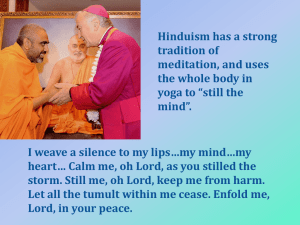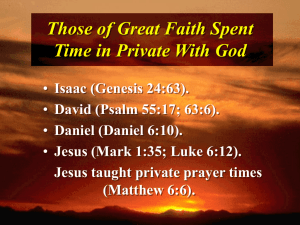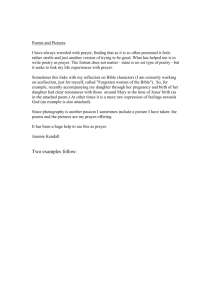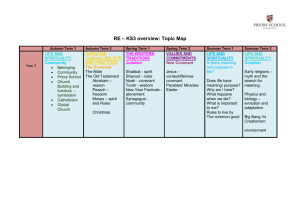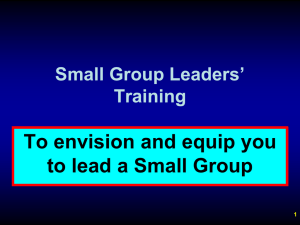Elaborations - Toowoomba Catholic Education
advertisement
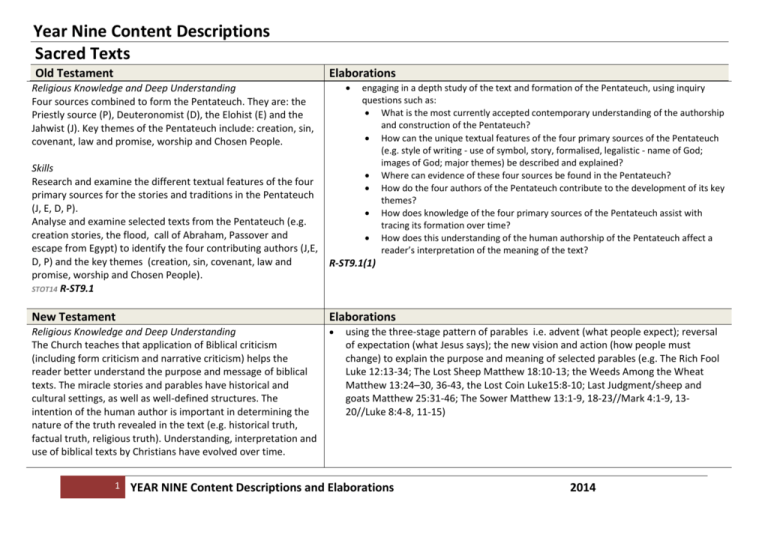
Year Nine Content Descriptions Sacred Texts Old Testament Elaborations Religious Knowledge and Deep Understanding Four sources combined to form the Pentateuch. They are: the Priestly source (P), Deuteronomist (D), the Elohist (E) and the Jahwist (J). Key themes of the Pentateuch include: creation, sin, covenant, law and promise, worship and Chosen People. Skills Research and examine the different textual features of the four primary sources for the stories and traditions in the Pentateuch (J, E, D, P). Analyse and examine selected texts from the Pentateuch (e.g. creation stories, the flood, call of Abraham, Passover and escape from Egypt) to identify the four contributing authors (J,E, D, P) and the key themes (creation, sin, covenant, law and promise, worship and Chosen People). STOT14 R-ST9.1 engaging in a depth study of the text and formation of the Pentateuch, using inquiry questions such as: What is the most currently accepted contemporary understanding of the authorship and construction of the Pentateuch? How can the unique textual features of the four primary sources of the Pentateuch (e.g. style of writing - use of symbol, story, formalised, legalistic - name of God; images of God; major themes) be described and explained? Where can evidence of these four sources be found in the Pentateuch? How do the four authors of the Pentateuch contribute to the development of its key themes? How does knowledge of the four primary sources of the Pentateuch assist with tracing its formation over time? How does this understanding of the human authorship of the Pentateuch affect a reader’s interpretation of the meaning of the text? R-ST9.1(1) New Testament Elaborations Religious Knowledge and Deep Understanding The Church teaches that application of Biblical criticism (including form criticism and narrative criticism) helps the reader better understand the purpose and message of biblical texts. The miracle stories and parables have historical and cultural settings, as well as well-defined structures. The intention of the human author is important in determining the nature of the truth revealed in the text (e.g. historical truth, factual truth, religious truth). Understanding, interpretation and use of biblical texts by Christians have evolved over time. 1 using the three-stage pattern of parables i.e. advent (what people expect); reversal of expectation (what Jesus says); the new vision and action (how people must change) to explain the purpose and meaning of selected parables (e.g. The Rich Fool Luke 12:13-34; The Lost Sheep Matthew 18:10-13; the Weeds Among the Wheat Matthew 13:24–30, 36-43, the Lost Coin Luke15:8-10; Last Judgment/sheep and goats Matthew 25:31-46; The Sower Matthew 13:1-9, 18-23//Mark 4:1-9, 1320//Luke 8:4-8, 11-15) YEAR NINE Content Descriptions and Elaborations 2014 Skills using the three-fold structure of miracle stories (i.e. problem or need; action; Investigate the main features of form criticism (classification of reaction) to explain the purpose and meaning of selected miracle stories (e.g. Cure of texts into text types; structure of texts; function of text in terms the paralysed man Mark 2:1-12//Matthew 9:1-8//Luke 5:17-26; Man by pool at of intended audience) and narrative criticism (the story aspect Bethesda John 5:5-18; wedding at Cana John 2:1-11; Multiplication of the Loaves of the text e.g. plot, setting, characters, literary techniques). John 6:1-15; Crippled woman Luke 13:10-16) Analyse text structures and language features of selected using the Bible respectfully miracle stories and parables using form criticism and narrative R-ST9.2(2) criticism. STNT19 R-ST9.2 Christian Spiritual Writings and Wisdom Elaborations Religious Knowledge and Deep Understanding The inspired writings of various religious and lay leaders (e.g. Catherine McAuley, Nano Nagle, Edmund Rice, Don Bosco, Elizabeth Seton and Mary MacKillop) responded in new ways to the needs of the faithful, especially through education, works of charity, and health care (c.1750CE-c.1918CE). Skills Explain how the writings and key messages of various religious and lay leaders (c.1750CE-c.1918CE) inspired and empowered others to respond to the needs of the faithful. STCW10 R-ST9.3 using a timeline tool (e.gTimetoast, Tiki-Toki ), trace the history of religious and lay leaders (e.g. Catherine McAuley, Nano Nagle, Edmund Rice, St Vincent de Paul, Elizabeth Seton and Mary MacKillop) and their practical responses to the needs of the faithful (e.g. education, health, charitable organisations) researching writings and key messages of religious and lay leaders and how these are intentionally promoted (e.g. brochures, iconography, mission and vision statement) and expressed in a contemporary context (e.g. Mater hospitals, schools, Caritas, Edmund Rice Centre, St Vincent de Paul Society, Mercy Heritage Centre) interviewing (e.g. forum) representatives of organisations identified above, that respond to people’s needs through education, charity and health care creating a visual presentation to highlight achievements of religious and lay leaders (e.g. peoplescape, collage, art instalment, digital representation) Resources: Elizabeth Seton – St Elizabeth Seton Ministries “A Time for Miracles” – DVD – ResourceLink (The DVD begins in 1964 with a cleric in the Vatican pleading with the committee for canonization to declare Elizabeth Seton a saint.) Catherine McAuley - Mater Hospital Vision and Mission St Mary of the Cross - Mary MacKillop Place Edmund Rice – The Edmund Rice Centre St Vincent de Paul – St Vincent de Paul Society Nano Nagle – Society of Presentation Sisters R-ST9.3(3) 2 YEAR NINE Content Descriptions and Elaborations 2014 Year Nine Content Descriptions Beliefs Trinity: God, Jesus the Christ, Spirit Elaborations Religious Knowledge and Deep Understanding The Incarnation, Resurrection and Ascension of Jesus are foundational beliefs of Christianity. The Incarnation teaches that Jesus is fully human and fully divine. The resurrection of Jesus confirms his divinity and reveals God’s gift of eternal life to all. The Catholic Church teaches that Jesus’ risen body, bearing the marks of crucifixion, ascended into heaven. Skills Identify the foundational beliefs of Christianity as expressed across a range of core Christian texts, including scriptural texts (Romans 1:1-7; 1 Corinthians 15:1-11; Acts 1:1-12 and John 9:1-39). Express ideas about the relevance and consequences of these foundational beliefs of Christianity for believers today (e.g. sacredness of human life, Church’s teaching authority, commitment to continuing Jesus’ mission to bring about the Kingdom). BETR12 R-B9.1 Human Existence Elaborations Religious Knowledge and Deep Understanding God created a world in a state of journeying to its ultimate perfection. The experience of sin throughout human history points to the presence of good and evil in an imperfect world. developing questions to frame inquiry such as: If God cares for the world and humanity, why does sin exist? Why is there suffering in the world? Why does a good, loving God permit evil things to take place? creating a visual representation of concepts such as good, evil, sin, suffering, creation, free will (e.g. using Wordle) 3 identifying words / phrases from across a range of core Christian texts (e.g. Nicene Creed, Scripture) that express a Christian understanding of Jesus’ Incarnation, Resurrection and Ascension (e.g.’ he became incarnate of the Virgin Mary, and was made man’ Nicene Creed new translation; “And the Word became flesh, and dwelt amongst us” John 1:14, Road to Emmaus Luke 24:13-35; Appears to disciples in Jerusalem Luke 24:36-49) examining some of the heresies about the nature and person of Jesus Christ (i.e. the Jesus of history and the Christ of faith) and their connection with the development of the Creedal statements (e.g. Arianism – the Son of God is "begotten, not made, of the same substance (homoousios) as the Father" CCC465) (Jesus and Christianity, pp. 27-28) discussing the implications of a foundational belief (Jesus’ Incarnation, Resurrection or Ascension) for the way Christians live today (e.g. use the Consequences Map strategy , A-Z Learning Strategies: “If Christians believe in Jesus’ resurrection, then …”) creating an informative or persuasive text that presents an understanding of a foundational belief (Jesus’ Incarnation, Resurrection or Ascension) and its implications for Christians today (e.g. living a healthy life; enabling the dignity of the aged and the disenfranchised; being a peacemaker; reconciling with others); publishing the text (e.g. using OneNote or YouTube) integrating visual, print and/or audio features R-B9.1(1) YEAR NINE Content Descriptions and Elaborations 2014 Skills Identify examples of good and evil co-existing throughout human history. Make connections between the experience of sin throughout human history, God’s gift of free will to humanity and the imperfect nature of God’s created world. Express ideas about the experience of sin in the world, using evidence identified in sources. BEHE9 R-B9.2 sequencing key world events and actions of individuals and groups in history that are examples of good and evil within a chronological framework reflecting on the idea of sin as “any action or omission that hinders, violates or breaks right relationships which support human well-being” (Richard M. Gula) and discussing examples of this understanding of sin in daily life in local, national and global contexts developing a discussion (e.g. oral or written) about the experience of sin in the world in response to ideas / interpretations presented by other sources (e.g. in selected quotes such as: o “In this less than perfect world, humankind exercises free will. … Free will has been God’s greatest and most risky gift to humanity” o “God has created a world that is less than perfect, or else it would be heaven, and in which suffering, disease, and pain are realities. Some of these we now create for ourselves and blame God.” o “When people say, “Why does God let famine and starvation happen?” I imagine God shaking his head in a tearful reply, “Why do you let famine and starvation happen?” … The same is true of other examples as well: environmental degradation, personal and social stress, and lack of action to end war. We choose the world to be like this, and then blame God for the negative fallout from our decisions.” o “God must take some responsibility for the world in which we live. He permits evil things to take place. (Reference: Where the Hell is God?, R. Leonard, 2010) “We can let ourselves be perpetually scandalized by the seeming triumph of evil, pain, and suffering in our world. God's silence can forever scandalize us: in the Jewish holocaust, in ethnic genocides, in brutal and senseless wars, in the earthquakes and tsunamis which kill thousands of people and devastate whole countries, in the deaths of countless people taken out of this life by cancer and by violence, in how unfair life can be sometimes, and in the casual manner that those without conscience can rape whole areas of life seemingly without consequence. Where is God in all of this? What's God's answer? God's answer is in the resurrection, in the resurrection of Jesus and in the perennial resurrection of goodness within life itself.” (Reference: Ronald Rolheiser OMI Easter reflection on God and suffering, April 2011) R-B9.2(2) 4 YEAR NINE Content Descriptions and Elaborations 2014 World Religions Elaborations Religious Knowledge and Deep Understanding Christianity, Judaism and Islam are monotheistic religions that share a belief in the one God (Allah, God, G*d). The three monotheistic religions have divergent understandings of God that are reflected in their beliefs and practices. Skills Explain why Christianity, Judaism and Islam can be defined as monotheistic religions. Examine and discuss the understanding of God/Allah/G*d in the monotheistic traditions that is reflected in the core beliefs and practices of the religion. BEWR10 R-B9.3 5 locating a definition for the term ‘monotheistic’ and constructing a personal definition researching the Islamic understanding of Allah through group or individual investigation e.g. What do the sacred scriptures (Qu’ran and Hadith) say that Allah is like? Do Muslims describe Allah in words or images? What images do Muslims put in their sacred space (Mosque)? How does the Adhan reflect a Muslim understanding of God? examining the Christian understanding of God through the Creeds and key passages in the Old and New Testaments examining the Jewish understanding through the Shema and key sections from Torah/Tanach e.g. Commandments, laws in Leviticus, images of G*d creating a visual representation of God that reflects the divergent understandings of God in the three monotheistic religions R-B9.3(3) YEAR NINE Content Descriptions and Elaborations 2014 Year Nine Content Descriptions Church Liturgy and Sacraments Elaborations Religious Knowledge and Understanding The Sacraments of Healing (Penance and Anointing of the Sick) call believers to conversion and loving trust in God’s healing grace. Through the Sacraments of Healing, the Christian community continues Jesus’ healing, care and compassion. Celebration of the Sacrament of Penance has changed over the centuries but has retained the same basic elements. In the Christian life, there are three forms of penance (prayer, fasting and almsgiving) which assist believers to reconcile themselves with God and others. Prayer, fasting and almsgiving encourage and strengthen believers and turn their hearts towards God and the needs of others. Skills Examine and explain the significance of the Sacraments of Healing (Penance and Anointing of the Sick) in the lives of believers. Describe how Jesus’ healing, care and compassion (Mark1:29-31; Mark1:40-50; Luke 5:12-16) are continued today through the Sacraments of Healing. Identify patterns of change and continuity over time in the celebration of the Sacrament of Penance. Examine and explain the significance of the three forms of penance in the lives of believers. CHLS14 R-C9.1 6 naming and defining each of the terms: Prayer; Fasting; and Almsgiving (e.g. using the Fishbone strategy) investigating experiences of the three forms of penance (i.e. prayer, fasting, almsgiving) in a range of settings (e.g. school, parish, family and community) Sacramental Celebrations Origins and Practices, p.34 investigating different experiences / perspectives of the Sacrament of Anointing of the Sick and discussing these perspectives (e.g. using the Six Thinking Hats strategy) Sacramental Celebrations Origins and Practices, pp.26,27 designing a ritual that could be used as a resource if a member of the school community were to become seriously ill Sacramental Celebrations Origins and Practices, p.36 investigating the purpose and meaning of the Sacrament of Penance for believers (e.g. interview a number of Catholics from the local parish or school community) Sacraments Past Present Future, pp. 37, 38 comparing and contrasting the structures of the three rites of reconciliation in light of the purpose and meaning of the Sacrament of Penance Sacraments Past Present Future, p.37 participating in a debate (e.g. Half Class debate strategy) critiquing the Rite of Reconciliation considering different contexts and stages of life sequencing chronologically the different stages in the development of the celebration of the Sacrament of Penance/Reconciliation over the 2000 years of Christianity, demonstrating the relationship between these events in different periods and places; using the years 50, 350, 950, 1450, 1850 and 2000 as marker dates Sacraments Past Present Future, pp.28,29 looking carefully at Roger Van Der Weyden’s altarpiece depicting the Seven Sacraments; what does his painting tell you about the celebration of the Sacrament of Penance in 1445? investigating and interpreting scriptural passages related to Jesus’ healing ministry (e.g. Mark 1:2931; Luke 4:38-39; Mark 1:40-50; Luke 5:12-16; Mark 2:1-12; Luke 5:17-26; Mark 3:1-6; Luke 6:6-11) and the ministry of the early Church (e.g. James 5: 14–15) Sacramental Celebrations Origins and Practices, pp.38 -41 Resources: Catholics: A Sacramental People Reconciling Reconciliation: Learning from the Sacrament’s History R-C9.1(1) YEAR NINE Content Descriptions and Elaborations 2014 People of God Elaborations Religious Knowledge and Understanding All lay people, through their baptism, share in a Christian vocation (Latin ‘vocátió’-‘calling’). A Christian vocation calls all people to develop to their fullest potential, so that they may be able to share their own individual gifts, talents, abilities and blessings as fully as possible, for the sake of others. Lay people witness to Jesus Christ by participating in his priestly, prophetic and kingly roles, and therefore bear responsibilities for mission and service. Lay people participate in the priestly work of Jesus Christ when prayer and worship are at the heart of their lives and when the Eucharist is the source and summit of their spirituality and their engagement with the world. Lay people participate in the prophetic work of Jesus Christ when they speak out against injustice, act to have human dignity respected and work for authentic freedom and mutual respect within family, workplace and in wider society. Lay people participate in the kingly work of Jesus Christ when they see whatever power and influence they have as an opportunity for Christian service and strive for social structures and processes that respect human dignity and promote authentic freedom. The kingly work of Jesus Christ is also enacted through lay participation in the leadership and governance structures of the Church. Skills Explain why lay people bear responsibilities for mission and service. Examine different ways that lay people participate in the priestly, prophetic and kingly work of Jesus Christ, providing contemporary examples of how they live their Christian vocation. . CHPG10 R-C9.2 7 identifying (using a strategy such as Hot Potato) a variety of social needs that exist in their community (e.g. unemployment, youth homelessness, affordable housing, respite care, aged care, transport, access to community infrastructure) investigating the work of welfare agencies from a variety of Christian Churches (e.g. schools, St Vincent de Paul, Centacare, Bluecare) in responding to these social needs as a way of living the Christian vocation (Church Challenges and Choices, p.31) integrating a justice focus into school liturgies, classroom prayer and prayer assemblies (e.g. draw on resources from Caritas, Catholic Mission, St Vincent De Paul) as a way of participating in the priestly work of Jesus Christ (Religious Life of the School P-12, SJS 2.1) reviewing and evaluating experiences offered by the school (e.g. overseas trips, formals, excursions, fundraisers, service learning) in light of the prophetic work of lay people auditing and evaluating policies, structures and practices in the light of the kingly role of lay people (e.g. school, government, Church, community) researching the daily life of a community whose main ministry and way of living their Christian vocation is through prayer (e.g. Taize community); The Carmelite community, Ormiston); Benedictine Monastic Community researching how communities such as the Benedictine Nuns at Jamberoo Abbey live a prayer ministry, praying for the needs of others using the BCE site to establish a prayer ministry for needs on a local, national and international level Resources: Religious Life of the School P-12: Social Action and Justice R-C9.2(2) YEAR NINE Content Descriptions and Elaborations 2014 Church History Elaborations Year Level Focus: The Church’s Response to the Making of the Modern World (c.1750 CE – c. 1918 CE) Religious Knowledge and Understanding locating, analysing and using relevant sources to inform an historical inquiry, e.g. In a time of great challenge and change (c.1750 CE – c.1918 CE), processing and synthesising information from a range of sources the Church had to respond to many internal and external threats to explaining the variations in perspective which can lead to different historical its physical existence, cultural influence, political influence, social interpretations structure, roles and relationships and economic power. identifying the origin, purpose and context of primary and secondary sources Recurring broad patterns of historical change (namely using inquiry questions such as: Construction: Searching for Unity, Order and Authenticity; What were the changing features of the relationship of the Church with its Deconstruction: Challenges to Unity, Order and Authenticity; followers and/or the wider society in the modern world? Reconstruction: Restoring unity, order and authenticity) are evident How did new ideas and technological developments contribute to changes in in the story of the Church in a time of challenge and change (c.1750 the economic power and/or cultural influence in this period? CE – c.1918 CE) as it was forced to question its nature and role in What was the origin, development, significance and long-term impact of the the world. Church’s missionary activity in this period? What was the significance of a key social upheaval in this period (e.g. Industrial Skills Revolution, the Scientific Revolution, The French and Russian Revolutions, Sequence significant events and developments in the Church World War I, egalitarianism, Enlightenment, emancipation of women, abolition (c.1750 CE – c.1918 CE) within a chronological framework (namely of slavery, labour movements) on the Church’s nature and role in the modern Construction: Searching for Unity, Order and Authenticity; world? Deconstruction: Challenges to Unity, Order and Authenticity; using historical terms and concepts such as: imperialism, nationalism, evolution, Reconstruction: Restoring unity, order and authenticity). atheism, scientific rationalism, sectarianism, modernist heresy, infallibility, Pose different kinds of questions to frame an historical inquiry communism, revolution, Marxism, abolitionism, emancipation, Darwinism, world about significant events or developments in the Church (c. 1750 CE war, colonisation, settlement, invasion – c.1918 CE). engaging in depth studies from The Australian Curriculum History, such as: Explain, discuss and compare different historical interpretations (including their own) about the Church’s past (c. 1750 CE - c.1918 Making a Better World CE), using historical terms and concepts and acknowledging The Industrial Revolution (1750 – 1914) sources of information. The population movements and changing settlement patterns during this CHCH8 R-C9.3 period The experiences of men, women and children during the Industrial Revolution, and their changing way of life; the responses from religious groups and the short and long-term impacts on the Church in the modern world, including the 8 YEAR NINE Content Descriptions and Elaborations 2014 Church in Australia. Progressive ideas and movements (1750 – 1918) The emergence and nature of key ideas in the period (e.g. socialism, nationalism, egalitarianism, imperialism, Darwinism); the reasons why this key idea emerged; the role of an individual or group in the promotion of this key idea, and the responses to it from religious groups; the short and long-term impacts on the Church in the modern world, including the Church in Australia. Movement of Peoples (1750 – 1901): Changes in the way of life of a group(s) of people who moved to Australia in this period, such as free settlers on the frontier in Australia The responses from religious groups and the short and long-term impacts of the movement of peoples on the Church in the modern world, including the Church in Australia. Australia and Asia: Making a Nation The extension of settlement, including the effects of contact (intended and unintended) between European settlers in Australia and Aboriginal and Torres Strait Islander peoples and the responses of religious groups Living and working conditions in Australia around the turn of the twentieth century (that is 1900) and the responses of religious groups (including the Church’s social justice encyclicals) World War 1 (1914-1918) The impact of World War I, with a particular emphasis on Australia and on the Church (such as the use of propaganda to influence the civilian population, the changing role of women, the conscription debate, the loss of faith) engaging in a depth study from Church History (c.1750 CE – c. 1918 CE), such as: The Church and the French Revolution The impact of the Religious Orders on the lives of ordinary people Different approaches taken by various Christian denominations to evangelising in the modern world (e.g. Evangelical crusades, Wesleyan Methodists, provision of education via Religious Orders and Lay Institutes) Spiritual and pious practices and devotions as a response to the modern world (e.g. Marian devotions, confession, sodalities) R-C9.3(3) 9 YEAR NINE Content Descriptions and Elaborations 2014 Year Nine Content Descriptions Christian Life Moral Formation Elaborations Religious Knowledge and Deep Understanding Respect for each person, as created in the image of God and as a reflection of God, is expressed through moral behaviour towards oneself and others. Two key principles of Catholic social teaching, namely respect for the dignity of the human person and human rights and responsibilities, provide guidelines for developing a healthy understanding of one’s personal identity and of human relationships. Skills Analyse and evaluate different perspectives on the dignity of the human person and human rights and responsibilities. Make judgements about behaviour towards one self and others, based on two key principles of Catholic social teaching, namely respect for the dignity of the human person and human rights and responsibilities. CLMF13 R-CL9.1 10 brainstorming a range of aspects of personal identity (Paper personalities, Moral Integrity) considering the concept of gender stereotypes in their lifetime (Moral Integrity, pp.11 -12) creating an identikit related to personal qualities (Moral Integrity, p.12) reflecting on their own identity – physical, social, cultural, sexual, spiritual, emotional (Moral Integrity, p.12) creating a response to their own self-identity (e.g. business card, personal web page, critiquing a personal online profile) identifying personal traits that hinder healthy relationships (Press my buttons, Moral Integrity, p. 14) investigating sexuality as God’s gift to the human person (e.g. Scripture, Church statements) defining healthy relationships (e.g. using Frayer Concept Model Strategy, A-Z Strategies) analysing examples of current social issues about abuse of the human person and human relationships (e.g. cyber bullying, online predators, sexting, advertising and the media) in relation to the principles of Catholic social teaching: human dignity; human rights and responsibilities debating reliability of the coverage in a range of news media on social issues related to moral behaviour Resources: Moral Integrity Identity Themes of Church Social Teaching Catholic Social Teaching Resources Moral Issues Living Life to the Full, 2005 Church Moral Teaching R-CL9.1(1) YEAR NINE Content Descriptions and Elaborations 2014 Mission and Justice Elaborations Religious Knowledge and Deep Understanding Assisted by the Holy Spirit, the Church draws on the teaching of Jesus and its living Tradition to respond to emerging moral questions about scientific and technological advances. Catholic social teaching proposes principles for reflection; provides criteria for judgment and gives guidelines for action. The principles of Catholic social teaching, especially promotion of peace, stewardship and common good, provide guidelines for scientific and technological advancement. Skills Apply the principles of Catholic social teaching, especially promotion of peace, stewardship and common good, to particular real world examples of scientific and technological advances. Present an argument, informed by the principles of Catholic social teaching, that expresses an opinion, justifies a position, and makes a judgement about an issue related to scientific and technologic advancement. CLMJ10 R-CL9.2 11 comparing and presenting a proposal (oral, written, multimedia) where a principle of Catholic social teaching is examined in a real world context related to scientific and technological advances (e.g. promotion of peace in the debate about weapons of mass destruction) composing a class anthology of poems or songs based on the Catholic social teaching principles of promotion of peace, stewardship and common good creating a collage of images that depicts an application of the principles of Catholic social teaching, especially promotion of peace, stewardship and common good conducting a media search for evidence for the Church voice in a current issue related to scientific and technological advancement (e.g. recycling of digital technology, bioethics, cloning, genetically modified food, weapons of mass destruction) reflecting on current justice initiatives/actions within the school community (e.g. using the Action Reflection Strategy or the Examen or See Judge Act) based on the principle of concern for the good of community Process for Reflecting on Action for Justice) locating and using resources provided by Catholic agencies (e.g. Caritas, Catholic Mission) to promote reflection on issues related to scientific and technological advancement (Religious Life of the School P-12, SJR 2.6) researching and utilising the writings and reflections of prominent advocates for social justice as a focus for reflection on actions undertaken through scientific and technological advances (Religious Life of the School P-12, SJR 2.7) Resources Australian Catholic Social Justice Council Christianity Preferred Futures p. 23 Religious Life of the School P-12 Bioethics Political and Economic Issues Human Rights Issues R-CL9.2(2) YEAR NINE Content Descriptions and Elaborations 2014 Prayer and Spirituality Elaborations Religious Knowledge and Deep Understanding Believers pray, drawing on the richness of scripture, the Catholic tradition and the wider Christian tradition, including the prayers and writings of Christian spiritual fathers and mothers (e.g. Catherine McAuley, Nano Nagle, Edmund Rice, Don Bosco, Mary MacKillop) to nurture their spiritual life. Believers pray for forgiveness and healing, including the Penitential Act. Skills Participate with respect in a variety of personal and communal prayer experiences, including prayers for forgiveness and healing. Analyse and explain the features of prayers from the Catholic and wider Christian traditions, including the prayers and writings of Christian spiritual fathers and mothers (e.g. language, vocabulary, images, purpose, context, structures, patterns, style). Identify and discuss the relevance of prayers from the Catholic and wider Christian traditions for people today. Create a response that draws on prayers from the Catholic and wider Christian traditions, using the creative arts (dance, drama, media, music or the visual arts). CLPS22 R-CL9.3 exploring the key quotes about prayer and the prayers of some of the Christian spiritual fathers and mothers (e.g. Catherine McAuley – Suscipe) exploring Scriptural references about prayer and ways of praying (e.g. Jesus prayed regularly, along and with others; Matthew 6) creating a billboard message drawn from some of the key messages from the Christian tradition (e.g. using a web tool such as Big Huge Labsor the school Billboard) using prayers drawn from the charism of the school (e.g. class prayer, whole school rituals and assemblies) to nurture the prayer life of the school (Religious life of the School P-12, ICE 1.4) creating and using set times for prayer and worship throughout the school day, including PC prayer and Religion classes (Religious Life of the School P-12, PWP 2.4) using a variety of traditional prayers and devotions for individual and communal use (e.g. The Confiteor, acts of contrition, intercessions for healing, petitions for forgiveness, Penitential Act) experiencing a diverse range of prayer (e.g. meditative prayer, communal prayer, traditional prayer, silence, spontaneous prayer) and cultural expressions of prayer incorporating prayers and rituals of forgiveness and healing into classroom practice, behaviour support strategies and the life of the school (Religious Life of the School P-12, PWR 2.6) Resources: Religious Life of the School P-12) Intercessions for the Sick R-CL9.3(3) 12 YEAR NINE Content Descriptions and Elaborations 2014 Religious Knowledge and Deep Understanding Meditative prayer uses silence and stillness to assist believers to listen and talk to God. Believers use a range of practices (including praying with labyrinths) for preparing the body and the mind for meditative prayer, and for engaging in the ‘work of meditation’. Christian Meditation is a particular form of meditative prayer drawn from the Christian tradition. It is ‘prayer of the heart’ which takes place in silence, with the aid of a mantra. The World Community for Christian Meditation recommends the use of the mantra ‘mara-na-tha’ (a word from Aramaic, the language of Jesus, meaning Come Lord). All forms of vocal and meditative prayer are intended to lead believers to contemplation. Contemplative prayer is the simple awareness of the presence of God. It is prayer without words or images. Skills Participate respectfully in meditative prayer, including Christian Meditation. Identify and use practices that assist preparation for and engagement in meditative prayer, including praying with labyrinths. CLPS23 R-CL9.4 13 researching individuals and groups who were significant in the development and renewal of the practice of Christian Meditation (e.g. the desert mothers and fathers, John Cassian, St Benedict, John Main, Laurence Freeman, the World Community for Christian Meditation) learning about different ways to pray, including Christian Meditation using the prayer word or mantra ‘ma-ra-na-tha’ learning different practices for preparing the body and mind for Meditative Prayer and Contemplative Prayer including praying with labyrinths creating and leading others in a meditative prayer experience, using selected practices and spiritual exercises (e.g. Christian Meditation) Resources Christian Meditation The World Community for Christian Meditation Coming Home: Christian Meditation for Children and Young People. Open Our Hearts - Christian Meditation for Children (Litmus Productions) PC Prayer Meditation and Reflection Silence, Stillness and Simplicity Strategies for Silence and Stillness Religious Life of the School P-12 Leading Meditative Prayer with Students Contemplative Prayer Insight Time App Meditation Bells App R-CL9.4(4) YEAR NINE Content Descriptions and Elaborations 2014

